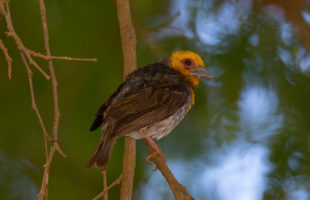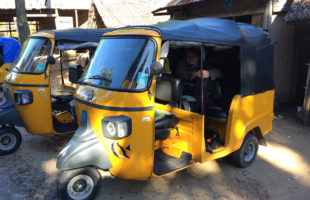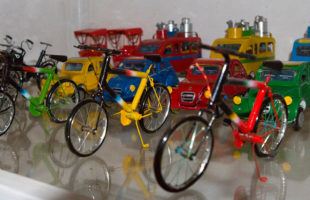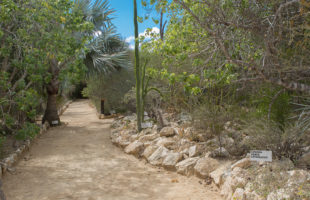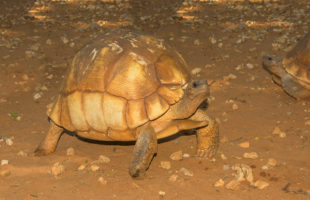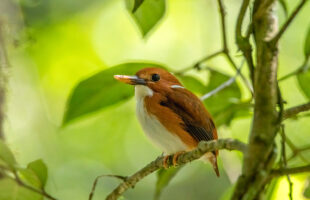The small, only 25 g weighing Sakalava weaver (Ploceus sakalava) only occur in Madagascar. As the name indicates, they belong to the weaver birds and are widely distributed around the island: Everywhere where the eponymous tribe of the Sakalava lives. This is mainly western Madagascar; from the deep, hot and dry South to the North. Sakalava weaver prefer dry areas. …
LesenMasika sipa
Tuk-Tuks
Especially in touristically heavily frequented places in Madagascar, it is impossible to imagine the street scene without them: Tuk-tuks. The bright yellow, small companions rush across the streets of islands like Nosy Boraha (St. Marie) and Nosy Be at a maximum speed of 40-50 km/h. They can now also be found in Toamasina (Tamatave), Toliara (Tuléar), Antsirabe, Ambanja, Sambava and …
LesenMamy’s miniatures
Madagascar’s handcrafts are as diverse as the island itself. A speciality is the manufacturing of small cars, bicycles and planes from old cans and other recycling materials. One has made a real art out of this: Mamy from Antsirabe in the southern highlands. Since 1990, he produces miniatures of bicycles, Taxibrousse, Pousse-Pousse, Renault R4s and other motorized vehicles. His work …
LesenProtected area Anjozorobe-Angavo
Anjozorobe-Angavo: The name Annjozorobe probably comes from the Madagascan “zozoro”, a certain kind of reed of the area. Legend has it that they were used as hiding places by the “menalamba”, who fought under the French colonial power for the liberation of Madagascar. Location: The protected area of Anjozorobe-Angavo is located 90 km northeast of the capital Antananarivo in the …
LesenArboretum Antsokay
Antsokay: The name means as much as “lime” and points to the typical loam and lime containing soil of the area. Around Arboretum, people make bricks from this kind of soil. Location: The Arboretum Antsokay is located in southwestern Madagascar in the region of Atsimo-Andrefana. It is only 12 kilometers away from one of the largest cities of the south, …
LesenThe real treasures of Madagascar
An arched, golden shell, relatively long legs and alert, black, shining eyes: That is how the most precious tortoise on Earth looks like. It comes from Madagascar and is named ploughshare tortoise (Astrochelys yniphora) due to the large bony appendage on its breast shell. It serves males to turn over contrahents or females during mating season. And this is quite …
LesenThe last Michelines
Madagascar is home to the last running Michelines worldwide. Indeed there exist other Michelines for example in France, but those are safely kept in museums. In contrast, two of these rail buses still chauffeur travelers around Madagascar – although it is restricted to a few times a year nowadays. André Michelin, who gave the name to his invention, developed the …
LesenThe fruit gourmets: Black-and-white Ruffed Lemurs
Many people know them from zoos and animal parks: Black-and-white ruffed lemurs (Varecia variegata). Besides Red Ruffed Lemurs and the Indri, they belong to the largest lemurs with a head-torso length of 40 to 60 cm, an additional 60 cm added for the tail. Weights of 3 to 4 kg are the average. Black-and-white ruffed lemurs exclusively live in the …
LesenSmall but a kingfisher: The Madagascar pygmy kingfisher
Kingfishers inhabit many parts of the world. But Madagascar has, additional to the usual kingfisher with its blue blaze of color, another extraordinary variant: The Madagascar pygmy-kingfisher (Corythornis madagascariensis). It bears its name rightly: The pygmy-kingfisher is only 13 cm in size and weighs only 20 grams. A real lightweight! This species also differs from its “big brother” in color: …
LesenThe sky blue reed frog
An especially pretty frog is the blue reed frog (Heterixalus madagascariensis) or Madagascar reed frog: There are yellow and sky blue variations, with yellow or orange arms, legs, hands and feet. In the sun, they often become almost white. Literature mentioned the sky blue frog for the first time in 1841: The French zoologist André Duméril and his assistant, Gabriel …
Lesen MADAMAGAZINE Your Magazine about Madagascar
MADAMAGAZINE Your Magazine about Madagascar
